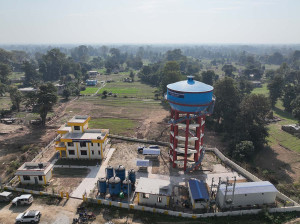Money
Interest rates likely to remain stable
Interest rates in the banking sector are likely to remain stable, but at the higher end, in the next fiscal year, as the central bank has sought to purchase excess liquidity of banks at a fixed interest of 3 percent.
Rupak D. Sharma
Interest rates in the banking sector are likely to remain stable, but at the higher end, in the next fiscal year, as the central bank has sought to purchase excess liquidity of banks at a fixed interest of 3 percent.
The Nepal Rastra Bank (NRB), the central bank, uses an instrument called term deposit to operate its interest rate corridor and mop up excess of liquidity from banks.
This instrument has a maturity period of two weeks. The rate of this instrument is currently fixed by deducting 10 basis points, or 0.10 percentage point, from weighted average interbank rate of commercial banks.
Currently, weighted average interbank rate of commercial banks hovers around 0.5 percent. This means the interest on two-week term deposit stands at 0.4 percent.
Considering this rate, a flat interest of 3 percent offered by the NRB through the Monetary Policy of the fiscal year 2017-18 launched on Sunday is quite high.
This is expected to encourage banks to park their excess liquidity at the central bank rather than lending it to other banks by engaging in interbank transaction-an operation under which banks extend loans to each other.
“This fixed interest policy adopted by the central bank will eventually raise interbank rates, meaning deposit and lending rates will also remain at a higher level in the next fiscal,” said Anil Shah, president of the Nepal Bankers’ Association, an umbrella body of commercial banks.
The intention of the central bank to keep interest rates at the higher end is consistent with its inflation target of 7 percent for the next fiscal year.
This inflation target implies consumer goods and services, on average, will become more expensive by 7 percent in the next fiscal year. In other words, the value of money will erode by 7 percent. To cover losses inflicted by inflationary pressure, deposit rates should stand at above 7 percent in the next fiscal year. Otherwise, those who park money in banks will not get any positive yield in real terms.
“We hope the policy of locking two-week term deposit rate at 3 percent will help keep retail deposit rates at the higher level,” said Shah, who is also the CEO of Mega Bank. “And when deposit rate goes up lending rates also rise automatically.”
This policy of fixing the term deposit rate is also expected to bring about stability in banking sector’s interest rates.
This is because the term deposit rate had fluctuated wildly in the current fiscal year because it was fixed on the basis of weighted average interbank rate of commercial banks. The average interbank rate of commercial banks, which stood at around 1.1 percent at the start of the fiscal year in mid-July, plunged to around 0.4 percent and then soared to as high as 7 percent before coming down to the current level of 0.5 percent.
Since these interbank lending rates are used as reference rates to fix the two-week term deposit rate, the term deposit rates automatically fluctuated wildly.
This was ironic because two-week term deposit rate forms the floor of the interest rate corridor, and the interest rate corridor, in turn, was introduced earlier in this fiscal year to reduce interest rate volatility.
The interest rate corridor basically operates using three different rates. First is the standing liquidity facility (SLF) rate. Using this rate, the NRB injects liquidity into the banking sector whenever there is shortage of funds. This rate has been fixed at 7 per cent; and it forms the upper bound, or ceiling, of the corridor. The latest Monetary Policy has given continuity to this rate.
Second rate used in the corridor is the repo, or policy, rate. NRB uses this rate to inject liquidity in the market for a period of two weeks. This rate floats in the middle of the corridor.
It is currently fixed by adding 200 basis points, or 2 percentage points, to weighted average interbank rate of commercial banks.
The latest Monetary Policy has fixed this rate at 5 percent.
The third rate used in the corridor is the two-week term deposit rate. This rate forms the lower bound, or floor, of the corridor.
“We hope the fixed term-deposit and repo rates will contribute to reducing volatility in market interest rates,” said NRB Governor Chiranjibi Nepal launching the Monetary Policy for 2017-18.
But there is a catch.
“For the interest rate corridor to function properly, the NRB must float instruments to mop up and inject liquidity at regular intervals,” said Sanima Bank CEO Bhuvan Kumar Dahal.
Dahal’s statement comes at a time when the central bank has failed to introduce adequate instruments to operate the interest rate corridor, and even when they were floated many banks did not subscribe to them.
Key targets of monetary policy
- Inflation – 7 percent
- Money supply growth – 18 percent
- Private sector lending growth – 20 percent




 18.12°C Kathmandu
18.12°C Kathmandu













